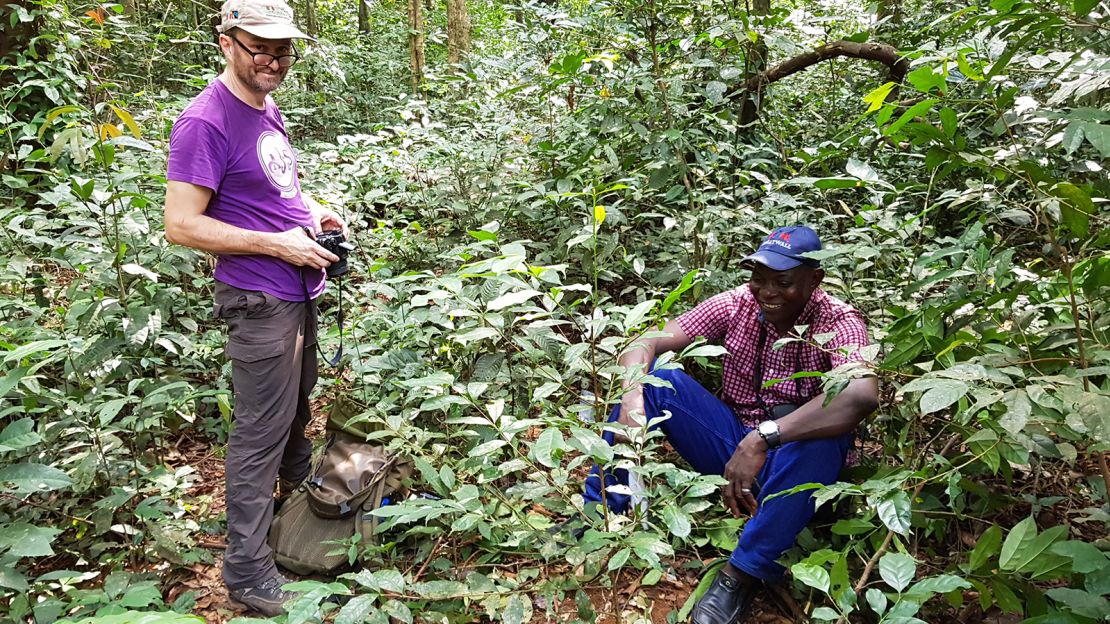About 200 miles southeast of Sierra Leone’s capital, agricultural researcher Daniel Sarmu made the discovery of a lifetime in the steep and humid Kambui Hills.
In 2018, Sarmu and two researchers from Kew Royal Botanic Gardens in the UK were on a mission to find the long-lost stenophylla coffee of Sierra Leone. The rare West African coffee plant hadn’t been seen in the wild there since 1954, although it had been spotted sporadically in Guinea and the Ivory Coast over the years.
The rediscovery of Sierra Leone’s highland coffee has renewed hopes that the uncommon crop could be cultivated and produced commercially – and help to revive the country’s floundering coffee industry, which was decimated by 11 years of civil war.
“Coffee could change the narrative for our farmers,” Sarmu tells CNN.
A rediscovered plant
After discovering a wild garden of around 15 stenophylla plants growing in the hills, the research team gathered samples for testing.
In their new study published this month, it was confirmed that stenophylla coffee is of high quality and excellent flavor, comparable to the best Arabica beans.
“Coffee markets are very interested in anything that’s different – particularly if it has good flavor attributes,” says Jeremy Haggar, an agro-ecologist at the University of Greenwich in the UK and one of the researchers who rediscovered the stenophylla coffee with Sarmu. “It’s highly likely that the specialty coffee market will be interested in it, and they may pay very high prices.”

Stenophylla coffee also grows in warmer temperatures, which means it could help the industry in its battle with climate change. Stenophylla can comfortably grow at temperatures up to 6.8⁰C higher than Arabica, which Haggar says could offer the industry a potential lifeline in a warming world.
This is good news for Sierra Leone, which is at the forefront of stenophylla’s revival. But there’s still a long road ahead before this rare bean makes its way into our coffee cups. The wild plant needs to be domesticated and further studied to develop better growth and management strategies.
Sierra Leone is one of the poorest countries in the world, so adding a high-value market could be a boon for its agricultural sector, which employs 75% of the population. One of the biggest challenges is funding, Sarmu says, but he’s committed to seeing stenophylla in Sierra Leone’s coffee farms once more.
A coveted coffee
“Coffea stenophylla” wasn’t always a rare commodity.
While researchers say 99% of the coffee we consume today comprises of Arabica and robusta, there are actually 124 species of coffee. There used to be much more diversity in coffee types, and Sierra Leone’s highland coffee was highly coveted.

“In the 1890s, it was stenophylla coffee that dominated the market,” says Sarmu. It was the preferred coffee of the French, and traded frequently into the 1920s.
But in the 1950s, robusta coffee was introduced to Sierra Leone by the British. Robusta is a more productive plant but is generally considered lower quality. As both coffees sold for the same price, farmers started replacing the old native crop. Over time, stenophylla was forgotten.
At this point, coffee was more important to Sierra Leone’s economy than cocoa (now one of the country’s top exports). Until 1991, Sierra Leone was exporting up to 25,000 tons of coffee annually.
But in that year, conflict in the neighboring country of Liberia, led by Charles Taylor, spread to Sierra Leone, triggering an 11-year civil war. Farmers abandoned the fields, says Sarmu – and the coffee industry disappeared.
A new coffee culture
When the civil war officially ended in 2002, many of Sierra Leone’s agricultural industries had to start over. The coffee sector never recovered, with annual exports falling to around 2,000 metric tons – while Ethiopia, the continent’s top producer, exported 234,000 metric tons last year.
Perhaps because of this, Sierra Leone has not developed its own unique coffee culture like some other coffee-producing countries. Rather than drinking homegrown products, locals can be seen drinking instant coffee from imported brands like Nescafe in the street market on their morning commutes.
However, that culture is starting to change, says Hannah Tarawally, founder of Coffee Courier, a coffee producer and cafe in the country’s capital, Freetown.
“Before, my friends don’t drink coffee, but because I introduced it to them, they can see and taste the difference,” she says. “So I think it will change for Sierra Leoneans, to start using our own local products.”

Tarawally began hand-roasting her own beans in 2015, and says she was one of the first in the country to do so. Her brand, Salone Coffee, now exports to Liberia and she hopes to enter the European market soon. In 2020, Coffee Courier opened its first cafe in Freetown – one of the country’s first dedicated coffee shops, an indication of the changing attitudes to homegrown products.
Tarawally isn’t the only one creating a domestic market for artisanal brews. Aromatic Coffee, a stall in a Freetown market, was one of the first in the city, and Nina’s Coffee, another Freetown coffee shop, hand-roasts its beans in-house.
When it becomes commercially available, the rediscovered stenophylla coffee could strengthen this burgeoning coffee scene – one that Tarawally hopes all Sierra Leoneans will take part in.
“We are not only targeting an international market, but we need to target our country,” says Tarawally. “We need to target the layman in Sierra Leone who can drink coffee, and make it a part of us all.”












